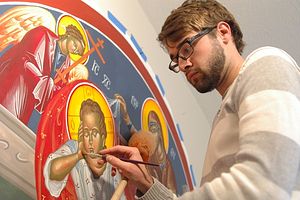But when this art teacher learned of the creativity grants for public school teachers offered by the Lilly Endowment, he submitted a proposal to study these ancient arts abroad. He hoped to take his training from mostly self-taught to securing apprenticeships under master artists in these fields. His dream became reality when his proposal was approved and funded by Lilly this past summer.
“I have always been an artist, both musically and visually. When I encountered the Orthodox Christian church, I was struck with the unapologetic role of the arts in the church,” said Whirledge, a six-year elementary art teacher in the Fairfield Community School District. “The walls of Orthodox churches are covered with icons (painted artwork of Jesus, Mary, Saints) and the services are entirely sung. Singing and painting were natural avenues for me to serve the church.”
Whirledge spent five weeks from May to July in Athens, Greece, receiving lessons from Ioannis Arvanitis, a master Byzantine chanter. Under his mentor’s guidance, Whirledge also sang with the St. Irene’s Church choir in Athens several times per week during church services.
“Byzantine music requires learning oral traditions through experience. St. Irene’s showcases the best Byzantine chant in the world,” said Whirledge. “A surreal moment was when a Greek friend in Chicago heard me singing in English on a radio podcast. St. Irene’s services are routinely broadcast on Greek National Radio.”
While in Greece, Whirledge also made side trips around Athens, as well as north to Mount Athos and to Naxos and Aegina, Greek islands in the Aegean.
“An experience of a lifetime were the days I spent on Mount Athos, which has been a Christian monastic refuge for over 1,000 years,” he said. “The most moving experience was the feast of St. Paul in Athens. The service took place on Mars Hill, steps from the Acropolis, where the Apostle gave his famous speech recorded in Acts 17 and converted the first Christians in Athens. Church bells were ringing throughout the whole city. There were thousands of people including dignitaries and military.”
Once back in America on July 4, Whirledge began the second part of his Lilly-funded trip in Long Island, N.Y.
“I assisted master iconographer Tom Clark on a project at Archangel Michael Greek Orthodox Church. I helped with borders and gold leaf gilding around a huge icon of Mary Mother of God, about 16 feet tall and 24 feet wide,” said Whirledge, who had never before created an icon mural of that caliber.
For two weeks, he assisted his mentor for as much as 16 hours a day. Despite long hours, Whirledge says every minute spent painting the icon confirmed his passion for this type of art.
“As an Orthodox Christian, icons are essential to our faith. They date back to the earliest Christians who worshipped in catacombs. While in Naxos, Greece, I saw iconography dating back to the fourth century, which is when the church first canonized the Bible as we know it,” he explained. “Being surrounded with images of Christ and the Saints reminds us of the great act of our salvation.”
By working with Clark, Whirledge learned valuable lessons on the technical process of creating large-scale icons, as well as the hard work that comes with being a professional iconographer.
“Being able to pursue my passions was amazing,” said Whirledge, who has implemented many musical techniques learned in Greece at his home parish, St. Mary’s Orthodox Church in Goshen, where he serves as the choir director. He has also recently completed the painting of a large icon, which will be installed in the church by Christmas.
“The best memory I have from Greece was how pervasive the faith permeated the culture. Churches were always filled with people, either going to services or lighting a candle before they went on with their days,” he said. “My goal is to continue improving the music at my own church and continue studying iconography, eventually painting icons for other churches.”
For more information about Whirledge’s iconography or to contact him, go to www.brianwhirledge.com.

